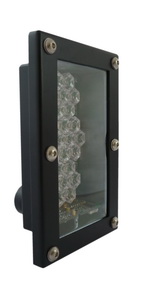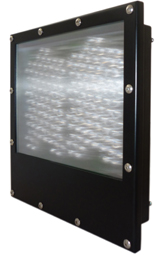|
||||||||||||||||||||||||||||||||||||||||||
|
||||||||||||||||||||||||||||||||||||||||||
VTR1 and VTR2 LED Lights
Go
to Gardasoft Vision
Go to
High Power for High Speed Lights
Go to Strobe Lights
Go to InfraRed Lights
High-intensity, strobed IR and white LED light source for traffic monitoring
The VTR range of LED light sources support a wide range of ANPR (automatic
number plate recognition) /LPR (licence plate recognition) -based applications.
From average speed monitoring to red light violation and parking access
and control, the VTR range of lights offers high-power, solid state lighting
with full remote control and easy synchronisation to the cameras.
The VTR lights are available in a choice of white and infrared
wavelengths. The beam angle can be specified
for a range of working distances. A trigger input can be used to synchronise
the lighting pulse with the exposure of a camera. Full intensity and pulse
width control are available through the trigger input and remote communications
port. There is an internal interlock to prevent the lighting
being triggered too fast. The compact housings are IP66 rated allowing
the lights to be installed very harsh environments.
The Gardasoft VCubed VTR lights provide a very powerful LED illumination
strobe for traffic monitoring solutions such as:
***Automatic number plate
recognition ***Face imaging
***Traffic speed management
***Vehicle type identification
The lighting is suitable for day time and night time operation.
| VTR1
- Compact. scaleable, high-ppwer output low maintenance, suitable
for harsh environments |
 Available
in a range of wavelengths (740nm, 850nm and 940nm as well as white
light) and various beam angles theVTR1 lights can be configured to
meet the spectral needs of the imaging system, along with the field
of view. If the appliction is a car park entry/exit situation or an
average speed installation spanning many lanes, the VTR1 offers a
light that will meet those ANPR illumination requirements. Available
in a range of wavelengths (740nm, 850nm and 940nm as well as white
light) and various beam angles theVTR1 lights can be configured to
meet the spectral needs of the imaging system, along with the field
of view. If the appliction is a car park entry/exit situation or an
average speed installation spanning many lanes, the VTR1 offers a
light that will meet those ANPR illumination requirements.
Available in either a single (master) light or as a pair (master
and slave), access to the light settings is done via a serial interface
which also offers light diagnostics. The thermal management of the
LEDs is critical to long service life and the temperature of the
light can be read via the serial interface. The VTR1 lights also
have an internal temperature limit and will automatically shut down
should the temperature exceed the limit. In the unlikely event that
an LED fails, this can also be diagnosed via the serial interface
and all settings are stored in non volatile memory. |
| VTR2 - High power, customisable, single housing, choice of IR wavelengths, fault-tolerant for low maintenance |
|
The VTR2 lights offer a 10x increase in light output compared to the VTR1 lights and are ideally suitedto applications where the working distance is increasing from the optical system to the subject. Having more light available also allows for more information to be gained from the image rather than just the vehicle number plate. Access to the light settings is done via a serial interface. This
interface also offers light diagnostics. The thermal management
of the LEDs is critical to long service life and the temperature
of the light can be read via the serial interface. The VTR lights
also have an internal temperature limit and will automatically shut
down should the temperature exceed this. In the unlikely event that
an LED fails, this can also be diagnosed via the serial interface.
All settings are stored in non volatile memory. |
Specifications
| Model |
VRT1 |
VTR2 |
| Wavelength |
740nm, 850nm, 940nm
and white
|
|
| Lighting drive power (pulsed) | 940nm: 101W, 850nm:
101W,740nm: 130W, White: 180W |
940nm: 1210W, 850nm: 1210W,
740nm: 1296W, White: 20252W |
| Typical number plate range at 850nm* | 12 degrees - 30m |
12 degrees - 200m |
| Trigger input | Optional,
5V to 24V opto-isolated with spike filtering
|
|
| Power supply requirements | 24V DC ±
5%. 1A |
24V DC ± 5%. 3.2A |
| Dimensions (excluding cable entry) | 148mm wide, 88mm
high, 55mm deep |
246mm wide, 256mm high, 50mm
deep |
| Mounting | M6 x
10mm thread studs
|
|
| Control/communication | Ethernet
or RS232
|
|
| Operating temperatures ** | -20
C to +60 C
|
|
| Weight | 0.6 Kg |
2.7 Kg |
| Environmental protection |
IP66 |
|
* Distance is a rough guide
only. Actual values will be a function of the applicaiton influenced by
the target, camera model, camera optices, exposure time and IR wavelength
used.
**
The lower temperature is based on the system being in operation when this
temperature is present. Precautions will need to be taken if turning on
the device from cold at the lower temperature extremes. There are restrictions
at higher ambient temperatures.
|
If you like this page, please recommend it and share it. |
|||
| More | |||




 The
VTR2 is an OEM product framework designed for customisation for
each application, enabling a precise feature set dependent on the
customer’s specification.
The
VTR2 is an OEM product framework designed for customisation for
each application, enabling a precise feature set dependent on the
customer’s specification.